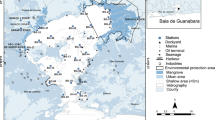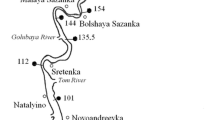Abstract
Introduction
In this work, sediments of the River Tisa (Tisza) are studied to assess their environmental pollution levels for some major heavy metals, as well as to predict the investigated elements’ mobility on the basis of their association type with the substrate. The Tisa River catchments area is a subbasin of the River Danube. Part of this river, 166 km long, belongs to the Serbian province of Vojvodina, before it flows into the Danube. It has been chosen for our investigation, because it has been exposed to intense pollution in the last decades.
Materials and Methods
The river sediment samples were collected at 32 locations. The proportions of sand, silt and clay fractions were determined. The sequential extraction procedure following a modified Tessier method was applied for speciation of the metal forms in the collected samples. The metal concentrations of Zn, Cd, Pb, Ni, Cu, Cr, Fe and Mn in extracts were determined by atomic absorption spectroscopy.
Results and Discussion
Granulometric analysis showed that some 50% of the Tisa River sediments were silt and clay, while the rest was sand with quartz, as the main constituent. The average metal content of the surface river sediment samples for every fraction of sequential extraction was presented and discussed in relation to pH, Eh and metal fractionation. The average metal content from the Tisa River sediments, obtained as an average of the metal’s concentration released in all five sequential extraction fractions was compared with: average metal contents of the Tisa River sediments in Hungary, metal content in soils formed on the Tisa River alluvium of Vojvodina, average metal content in soils of Vojvodina, and average metal content in soils of Hungary. An assessment of metal pollution levels in Tisa River sediments was made by comparing mean values for obtained results for the Tisa River sediments with the freshwater sediment’s Quality Guidelines as published by US EPA, Environment Canada and soil standards for Serbia.
Conclusion
According to US EPA and Canadian Quality Guidelines for freshwater sediments, the concentration of heavy metals in Tisa sediments were: (a) much higher than defined concentrations below which harmful effects on river biota are unlikely to be observed, (b) below defined concentrations above which harmful effects on river biota are likely to be observed. The concentration levels of Pb, Ni, Cu and Cr in Tisa River sediments are safe when compared with Serbian MAQ (Maximum Allowed Quantity) standards for soils, but they are unsafe in the case of Zn and Cd.
Recommendations and Outlook
The quality of sediments in the Tisa River was on the border line between potentially polluted and polluted. This line could very easily be exceeded since the quality of sediments in the Tisa River in Hungary was already worse than in Serbia. These results indicated the need for further monitoring of heavy metals in that locality.
Similar content being viewed by others
References
Akcay H, Oguz A, Karapire C (2003): Study of heavy metal pollution and speciation in Buyak Menderes and Gediz river sediments. Water Research 37, 813–822
Assessment Mission to Hungary and Romania UNDAC Mission Report (2000): United Nations Environment Programme. UNEP/Office for the Co-ordination of Humanitarian Affairs, OCHA, Geneva
Brayner FMM, Silva HKP, Freitas Barbosa AM (2001): Speciation of Heavy Metals in Estuarine Sediments in the Northeast of Brazil. Env Sci Pollut Res 8(4) 269–274
Brookins DG (1988): Eh-pH Diagrams for Geochemistry. Springer-Verlag, Berlin Heidelberg New York London Paris Tokyo
Clevenger TE (1990): Use of sequential extraction to evaluate the heavy metals in mining wastes. Water, Air, and Soil Pollution 50, 241–254
Chen ZS, Lee GJ, Liu JC (2000): The effects of chemical remediation treatments on the extractability and speciation of cadmium and lead in contaminated soils. Chemosphere 41, 235–242
CseQGs (2003): Summary of Existing Canadian Sediment Quality Guidelines, Environment Canada, 〈http://www.ec.gc.ca/CEQG-RCQE/English/Ceqg/Sediment/default.cfm〉.
Dauvalter V (2000): Ioxicity of heavy metals accumulated in lake sediments. Env Sci Pollut Res, Special 7(1) 66.1, p 3.1
Fleit E, Lakatos G (2003): Accumulative heavy metal patterns in the sediment and biotic compartments of the Tisza watershed. Toxicology Letters 140–141, 323–332
Korunović RM, Stojanović SV (1975): Laboratory manual in pedology, The fourth supplemented and broadened edition, The student’s association of Faculty of Agriculture, Beograd — Zemun, pp 23–31
Kostić N (2001): Distribution and Chemical Speciation of some Heavy Metals in Soils of Vojvodina and Central Serbia. Proceedings of the 10th Congress of Yugoslav Soil Sci Soc, CD copy by Soil Sciences Institute, Belgrade
Lovley DR, Goodwin S (1988): Hydrogen concentrations as an indicator of the predominant terminal electron-accepting reactions in aquatic sediments. Geochimica et Cosmochimica Acta 52, 2993–3003
Nguyen HL, Leermakers M, Osan J, Török S, Baeyens W (2005): Heavy metals in Lake Balaton: Water column, suspended matter, sediment and biota. Science of the Total Environment 340, 213–230
Official Gazette, Republic of Serbia (1990): No. 11, p 239
Polić P, Pfendt P (1992): Iron and manganese oxides as dominant nickel substrates in the Novi Beograd aquifer. J Serb Chem Soc 57(10) 697–703
Procopio JR, Gismera Garcia MJ, Lacal del Val J, Sevilla Escribano MT, Hernandez LH (2000): Kinetic Study of Potential Mobility and Toxicity of Heavy Metals in River Sediments. ESPR — Env Sci Pollut Res, Special 7(1) 46, p 1.23
Protić M (1984): Petrology of sedimentary rocks, Faculty of Mining and Geology, Belgrade, pp 6–191
Schintu M, Kudo A, Sarritzu G, Contu A (1991): Heavy metal distribution and mobilization in sediments from a drinking water reservoir near a mining area. Water, Air, and Soil Pollution 57–58, 329–338
Tam NFY, Wong YS (2000): Spatial variation of heavy metals in surface sediments of Hong Kong mangrove swamps. Environmental Pollution 110, 195–205
Teixeira EC, Ortiz LS, Sanchez JD, Alves M (2000): Heavy metals geochemical distribution in fluvial sediments of Baixo Jacui Region, RS, Brazil. Env Sci Pollut Res, Special 7(1) 75.1, p 3.19
Tessier A, Campbell PGC, Bisson M (1979): Sequential Extraction Procedure for the Speciation of Particulate Trace Metals. Analytical Chemistry 51, 844–851
Ubavić M, Bogdanovic D, Dozet D (1993): Heavy metals and pesticides in the Vojvodina soils. Faculty of Agriculture, Novi Sad, pp 217–222
US EPA (2002): A Guidance Manual to Support the Assessment of Contaminated Sediments in Freshwater Ecosystems. US EPA-905-B02-001-C
Watanabe I, Furusaka C (1980): Microbial ecology of flooded rice soils. Adv Microb Ecol 40, 125–168
Wong SC, Li XD, Zhang G, Qi SH, Min YS (2002): Heavy metals in agricultural soils of the Pearl River Delta, South China. Environmental Pollution 119, 33–44
Author information
Authors and Affiliations
Corresponding author
Rights and permissions
About this article
Cite this article
Sakan, S., Gržetić, I. & Đorđević, D. Distribution and fractionation of heavy metals in the Tisa (Tisza) River sediments. Env Sci Poll Res Int 14, 229–236 (2007). https://doi.org/10.1065/espr2006.05.304
Received:
Accepted:
Published:
Issue Date:
DOI: https://doi.org/10.1065/espr2006.05.304




